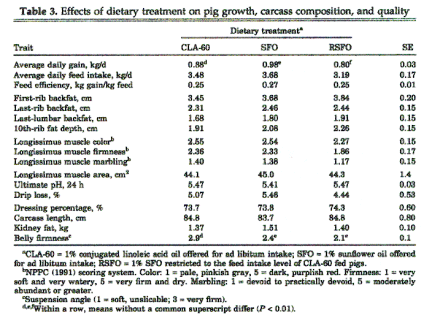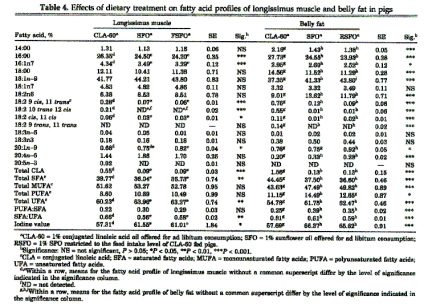Previous Page | Right click this page to print.
Nutritional Approaches to Improve Meat Quality
The last part of the class, I really want to kind of inject some of the cutting-edge type of nutritional approaches that the swine industry is going to start to adopt. Basically, this is closer to the work I am doing and the work I am interested in. And it involves using a nutritional approach again, but this time to impact meat quality.
Now, a couple of things you need to know about meat quality. Consumers tend to like no fat trimmings on their meat. They do not want to buy a pork chop they’ve got to trim fat off. But, they want a well-marbled pork chop. You somehow have to prevent fat from being put on in the subcutaneous parts of the pig, but you have to get fat into the muscle. You just cannot really do that. We have not figured out a way to do it yet. Typically, you have to put on the backfat before you can put in the intramuscular fat. It is a big limitation for a swine producer. We have to give the consumer fat with no fat. It seems like almost an impossible problem. We have already talked about a couple of ways the swine industry has thought about solving the problem.
The first one is genetics. That has been really effective. We can, just through selection for lean animals. They’ve dramatically limited the amount of fat that’s in a pig. A couple of other ways have been through using growth hormone and using Paylean. The problem with that is you may make a pork chop that has the right composition, that consumers say they want. But, then you have to deal with the fact that you’ve used hormones to make it. Anybody familiar with the dairy industry is probably sensitive to the kind of backlash you may face. If you remember Monday, when I put up that one graph showing market-share of pork versus beef and dairy protein products, anything that affects consumer perception of your product can really dramatically affect your market share. And that is the last thing you want to do, even if it theoretically helps your bottom line. If no one is going to buy your product, does it really help you?
A couple things you can do with a nutritional approach. Consumers typically
do not want to see animal fat. They think it gives you heart attacks.
But it turns out, in human nutrition, there is good fat and there is bad
fat. The good fat tends to be polyunsaturated fats. The bad fat tends
to be just your saturated fat. Well, animal fat is typically saturated
fat. So animal fat has gotten a bad rap. Meat products from animals are
really considered unhealthy. If you ask a doctor, especially if you have
high cholesterol. What is the first thing he is going to tell you to do?
Limit your fat, do not eat meat products. It is the last thing we want
consumers to do.
One exciting area in feeding a designer fat is CLA, conjugated linoleic
acid. And I will explain in a little bit why this is so exciting. The
reason I am calling this feeding a designer fat is we are going to add
certain kinds of fat into the ration and as it turns out a pig can actually
deposit dietary fat into their tissues in roughly a one to one ratio.
If you put one gram of CLA in the ration, that one gram will end up in
the pig somewhere. The idea is since we know that, we have that relationship,
let us feed the pig the healthy, good-for-you-fat and we can alter the
composition of the meat, the steak, the pork chop, whatever, the ham.
Then, we can actually market it heart-healthy. When you go to a meat counter
and you have someone trying to decide what to buy and then they have a
choice between something that is going to help their heart versus something
that their doctor tells them not to eat, it is a win-win situation.
Also, I talk about favorably altering the carcass composition to affect the tensile properties of the meat. Basically, means trying to find the right ratio between fat and muscle, so that you limit fat, but you do not affect the ability of the carcass to be processed in the packing plant. Part of the problem with genetic selection is it’s been very effective at reducing carcass fat, but it has gone past a quality point that is acceptable. We have got carcasses that are just too lean to be effectively cut when they go through the packing plant. Anytime you stop a packing plant, for even half an hour, you cost them a lot of money.
I wanted to get back to conjugated linoleic acid or CLA for short. Basically,
CLA is just an isomer of linoleic acid. That means linoleic acid, which
is an essential fatty acid, has been somehow changed into a new fatty
acid that is called CLA. It is produced naturally by rumen fermentation.
So this means the dairy people have a leg up because they can already
say our product is CLA-enriched and it is done naturally. The beef industry
is actually trying to figure out a way they can capitalize on this as
well. The important thing from the producer standpoint is CLA reduces
the fat content in animals. You feed a fat in a small amount in a ration,
you can actually dramatically decrease the amount of fat that the animal
is actually is going to put on. Plus, you are enriching the meat product
with CLA. And as it turns out CLA also has positive health benefits for
humans. It is thought to help prevent cancer. It’s thought to actually
make humans leaner. And it’s thought to also help protect against
developing arteriosclerosis. Now, none of those effects in humans have
been definitively proven. But, enough people are actually starting to
get excited about it that it is becoming more accepted. You can walk actually
into a general nutrition center and you buy CLA supplements. Just the
idea that you could put something that people are excited about, for their
own health, into the meat is a very positive thing.
This summarizes the effect of CLA in growing pigs.
- Larger sized table
- Link opens new browser window.

Eggert et al., 2001
- Larger sized table
- Link opens new browser window.

Eggert et al., 2001
There’s probably been about 50 growth studies done now. I am pretty
confident in saying this stuff works like we say it works. If you look
at growth performance. Daily gain, it has either increased or at worst
there has been no change. So you are making more of the product you are
going to sell. Feed intake, no change or it decreases. So feed efficiency
increases. So that’s good. By feeding CLA, you’re basically
having to spend less money to feed the animal and you are getting more
out of the animal. That is a dream for a pork producer. At what is more?
CLA is naturally made by animals. It is a natural product. So you do not
have people yelling at you that you’re giving your animal hormones.
From a quality standpoint, remember I was trying to define quality as
having little fat, but capable of going through a packing plant without
shutting the line down. Total fat was decreased by CLA. Total muscle on
the animal is increased. Backfat is decreased. Backfat is actually the
parameter used to measure total carcass fat in a pig. Most of their fat
is actually put on between their shoulders and their ham. On their back,
loin-eye area. This is basically a measure of your pork chop, which is
obviously an economically important cut in the pig, it increases. Your
belly. This is where you get your bacon. They’re cut off strip-wise
from the ribs. You increase the firmness. Just by adding CLA that part
of the carcass becomes firmer, which means you can get a leaner animal
through the packing plant. So it is another possible benefit of feeding
this fat. You have a genetically lean animal. Let's say you have selected
to the point where you have got some great growth performance, then you
have problems with the carcass to the packer. Well take your good genetics,
do not scrap them, feed them CLA. Also, meat marbling and color. They
actually enhanced positively. The point is just about every aspect you
would hope your pig to improve upon gets improved upon with feeding CLA.
Previous Page | Right click this page to print.